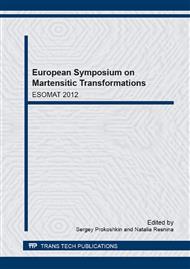p.228
p.237
p.242
p.247
p.252
p.257
p.262
p.269
p.274
Shape Recovery in Stainless FeMnSiCrNi(-Co) SMA Processed by ECAE
Abstract:
Stainless shape memory steel presents reasonable shape recovery but lower than the traditional NiTi shape memory alloys (SMA). However, recent results have shown that the shape recovery could be improved by decreasing the austenitic grain size. The present work describes the influence of the austenitic grain size on the shape recovery in stainless shape memory steel deformed by equal channel angular extrusion (ECAE) using a die intersection angle of 120o. Two alloys, FeMnSiCrNi and FeMnSiCrNiCo, were deformed by 1 ECAE pass and then they were compared in the deformed state; deformed and annealed in different temperatures for 1 h, resulting different grain sizes. Both alloys were evaluated by compression tests and the results shows an increase in total shape recovery related to grain size decrease. The best total shape recovery was 73% after a pre-strain of 4% for FeMnSiCrNi alloy.
Info:
Periodical:
Pages:
252-256
Citation:
Online since:
January 2013
Keywords:
Price:
Сopyright:
© 2013 Trans Tech Publications Ltd. All Rights Reserved
Share:
Citation:


